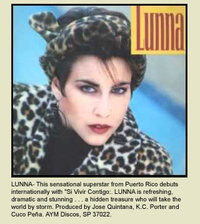I have a question about what I'm terming "Latin" music. Being located in Florida, I find myself in a number of either public places or within earshot of someone playing recorded music with Spanish lyrics. We have workmen in the neighborhood who bring music with them, I sometimes go to a barber shop where the barbers are all Hispanic, and the music playing is always what I would term "Latin". We have a number of Spanish radio stations and TV stations that I pass by in searching stations.
Now I know that there are regional differences in Spanish/Latin music. Some of it emanates from the Islands, some from Mexico, some from South America, and even Spain. But my question has to do with the gender of the singers. It seems to me that nearly 100% of the time, I'm hearing male vocals when I hear this music out in public. And I ask this question because of my own fondness for female vocals. Just in the A&M world alone I've gravitated toward Lani Hall of course, Maria Conchita Alonso, and Lunna. I've also heard Vikki Carr and Linda Ronstadt do some stuff in Spanish, and I generally like a lot of it. I don't know very many words in Spanish, so I'm basing all of my likes on the sound of the recordings, the chord structures, the instrumentation and arrangements, I like much of what I've heard.
So why is it that every time I pass by a radio station or a construction site or a barber shop, I'm always - always hearing male vocals? Anyone got a clue?
Now I know that there are regional differences in Spanish/Latin music. Some of it emanates from the Islands, some from Mexico, some from South America, and even Spain. But my question has to do with the gender of the singers. It seems to me that nearly 100% of the time, I'm hearing male vocals when I hear this music out in public. And I ask this question because of my own fondness for female vocals. Just in the A&M world alone I've gravitated toward Lani Hall of course, Maria Conchita Alonso, and Lunna. I've also heard Vikki Carr and Linda Ronstadt do some stuff in Spanish, and I generally like a lot of it. I don't know very many words in Spanish, so I'm basing all of my likes on the sound of the recordings, the chord structures, the instrumentation and arrangements, I like much of what I've heard.
So why is it that every time I pass by a radio station or a construction site or a barber shop, I'm always - always hearing male vocals? Anyone got a clue?


